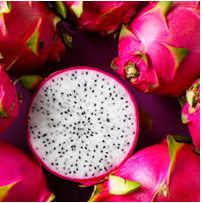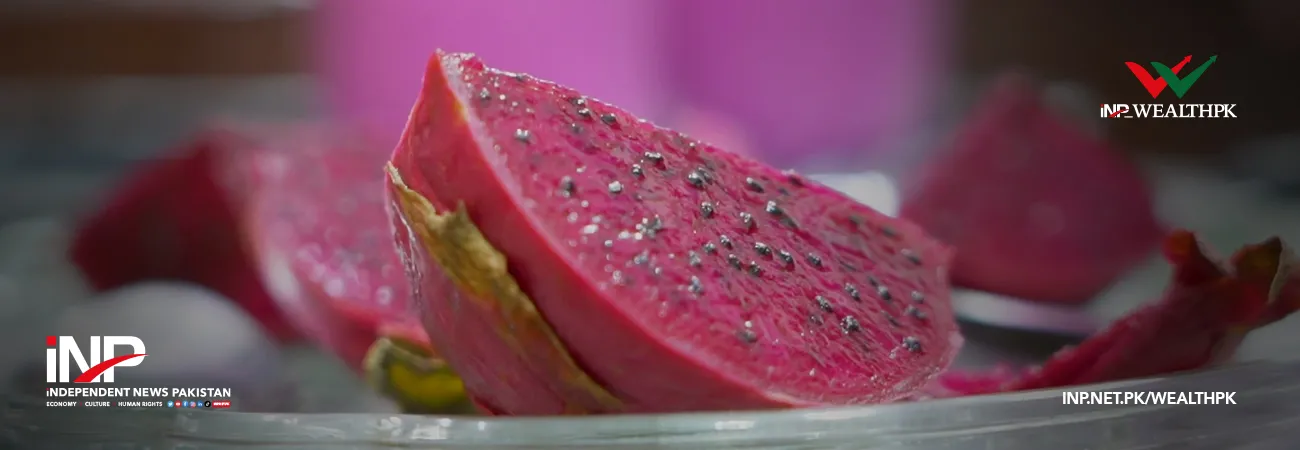i INP-WEALTHPK
Muhammad Luqman
The dragon fruit field in Jallo village near Lahore has become a popular attraction, showcasing the successful cultivation of this exotic fruit in Pakistan. Located near the India-Pakistan border, this field is part of a larger initiative to promote dragon fruit farming in this part of the world.

The farm owned by a Chinese couple has proved a role model for the progressive farmers in the central Punjab and Sindh with the cultivation of dragon fruit in Sheikhupura and Mandi Bahauddin districts and Gadap area in Karachi. The unique qualities of dragon fruit, such as its vibrant colours, refreshing taste, and nutritional benefits, are the major factors responsible for quick adoption in Pakistan.
The use of Chinese high-quality dragon fruit seedlings, scientific management, and planting technology has also contributed to the success of dragon fruit cultivation in the region. The cultivation of dragon fruit of three varieties – red, white and yellow – in Lahore has not only provided a new source of income for local farmers. However, it has also made the fruit more accessible and affordable for consumers in Pakistan. Prior to its local production, dragon fruit was mainly imported from countries like Vietnam and Thailand, making it an expensive delicacy.
Dragon fruit, an herbaceous perennial climbing cactus widely known as Pitaya, originates in Southern Mexico, Central America and South America. It is widely cultivated in Southeast Asia, India, the US, the Caribbean Islands and Australia.
“We initiated the dragon fruit cultivation on this farm some seven years ago. Now, things have become stable. The per acre yield from the farm is 10 tonnes,” Muhammad Munib, the manager of the farm, told WealthPK. He said that there is great potential for the production of exportable surpluses of the fruit. “With the support of strategic partnerships, government initiatives, and the dedication of Pakistani growers and exporters, the export of Pakistani dragon fruit to the neighbouring countries is possible,” he said.
He said that exports could be possible by exploiting the fullest yield potential of the crop, which is about 40 tonnes per acre in China and the United States. Most of the demand for dragon fruit is in the urban centres of Pakistan like Lahore, Islamabad and Karachi. Due to its high price ranging from Rs1,500 to Rs2,500 per kilogramme, it is presently available only on the shelves of big departmental and cash and carry stores in these cities. The dragon fruit is an excellent source of vitamin C, iron, magnesium and anti-oxidants in addition to carbohydrates.
“This fruit of sour-sweet taste has been of great benefit to diabetics and heart patients. With big quantity of anti-oxidants, it reduces the risk of cancer,” renowned nutritionist Dr Shagufta Feroze told WealthPK. She said that the fruit can be directly consumed as table fruit besides in the form of milkshakes, ice cream and fruit smoothies.
Despite the economic and health benefits of the dragon fruit, no serious efforts have been made by the horticultural research institutes at the federal and provincial levels to boost its production. The local and traditional fruits like mango, citrus and apple have been the focus of all the research.
“We may launch a project for the promotion of dragon fruit and other exotic fruits in case of any go-ahead from the government,” said Dr Ijaz Ahmad Jitala, Director of Fruit and Vegetables, Punjab Agriculture Department, while talking to WealthPK. He said that the development of commercial varieties locally can bring down the cost of production of this exotic fruit besides making it most affordable for the consumers.
Credit: INP-WealthPk









